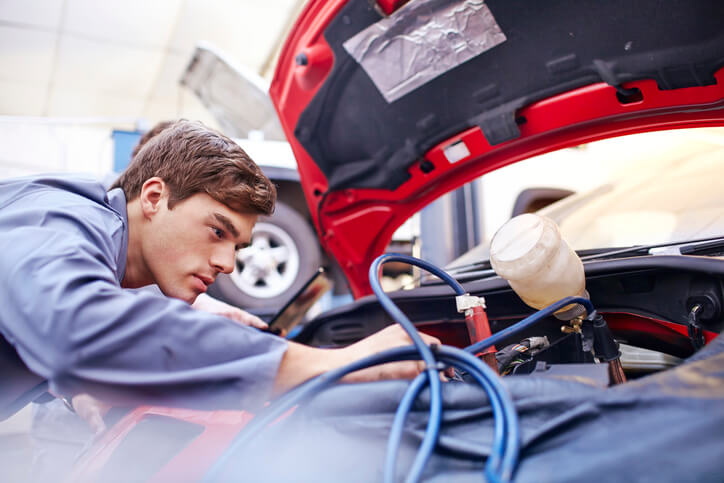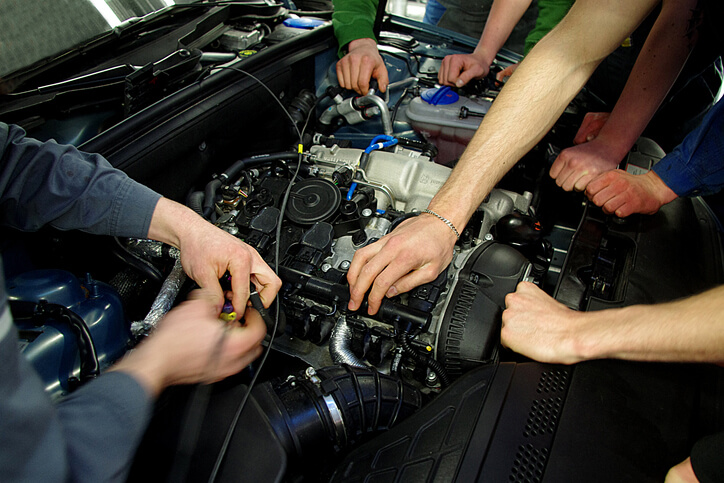Using Smoke Machines in Diagnostics: A Step-By-Step Guide for Auto Mechanic Technicians
When chasing down vacuum leaks, evaporative emission issues, or elusive engine misfires, sometimes visual inspection or scan tools just aren’t enough. That’s where smoke machines come in, a vital tool for any auto mechanic seeking fast, accurate diagnostics.
At ATC Surrey, students in our auto mechanic school learn to use smoke machines as part of their automotive training, helping them build confidence in diagnosing problems that are otherwise invisible. Let’s walk through what smoke machines do, how they work, and how future mechanics can use them in the field.
What Is a Smoke Machine and Why Use It?
A smoke machine, or smoke leak detector, introduces a visible, non-toxic vapor into a sealed automotive system, usually the intake, EVAP, or exhaust. The vapor fills the system, escaping through any leaks, and the escaping smoke pinpoints cracks, loose connections, or failing seals.
Unlike other methods, smoke machines:
- Provide visual confirmation of a leak
- Locate multiple leaks at once
- Can test complex systems like turbochargers or fuel vapor lines
- Save time and eliminate guesswork
This tool is indispensable for working on modern vehicles with intricate systems that are difficult to access or troubleshoot.
Common Issues Smoke Machines Help Diagnose
Smoke testing plays a critical role in diagnosing:
- Vacuum leaks that lead to a rough idle or poor fuel economy
- EVAP system leaks that trigger the check engine light (P0442, P0455, etc.)
- Intake manifold leaks that cause lean conditions or misfires
- Exhaust leaks that affect sensor readings
- Turbo system issues, including intercooler hose leaks
These are problems that traditional methods, like water spraying, propane injection, or code-reading alone, often miss or misinterpret. At an auto mechanic school like ATC Surrey, students are trained to rely on smoke testing early in the diagnostic process to avoid part-swapping or misdiagnoses.

Step-By-Step for Auto Mechanics: How to Use a Smoke Machine
Here’s how aspiring technicians are taught to use a smoke machine correctly at ATC:
- Prepare the system
Ensure the vehicle is turned off and cooled down. Seal the system to be tested, such as intake, EVAP, or exhaust. Disconnect components like air filters or purge valves if needed. - Connect the machine
Attach the smoke hose to the appropriate port (e.g., intake boot, EVAP service port, or exhaust tip). Clamp the hose securely. - Activate the smoke
Turn on the machine. Most use mineral oil or a special smoke fluid. Vapor starts filling the system within seconds. - Observe the leak
Use a flashlight to inspect for escaping smoke. Leaks may appear as a steady stream, puffs, or faint wisps. Pay attention to intake boots, gaskets, vacuum lines, and plastic fittings. - Document and repair
Once the leaks are located, record their positions, make necessary repairs, and retest the system to ensure complete sealing.
This technique is explored alongside other key diagnostic processes in our automotive training programs to help students master efficient, real-world problem-solving.
Safety Tips for Smoke Testing
- Always test in a well-ventilated area
- Avoid using smoke near hot exhaust components
- Use OEM-approved ports and avoid introducing smoke into sensitive electronic systems
- Wear eye protection when observing from close distances
Following these precautions ensures safe operation and extends the life of auto mechanic diagnostic equipment.

Why ATC Surrey Emphasizes Diagnostic Tools
In modern repair environments, diagnostics are half the job. Mastering tools like smoke machines gives future technicians an edge, allowing them to reduce labor time, impress employers, and build customer trust.
That’s why the auto mechanic training at ATC Surrey goes beyond the basics. Students not only learn theory, they work hands-on with industry-standard tools and scenarios they’ll encounter in the field.
Whether you’re preparing to work in a dealership, a private garage, or your repair shop, understanding how to use a smoke machine sets you apart from other graduates.
Are you looking for comprehensive automotive training?
Contact ATC Surrey for more information.


